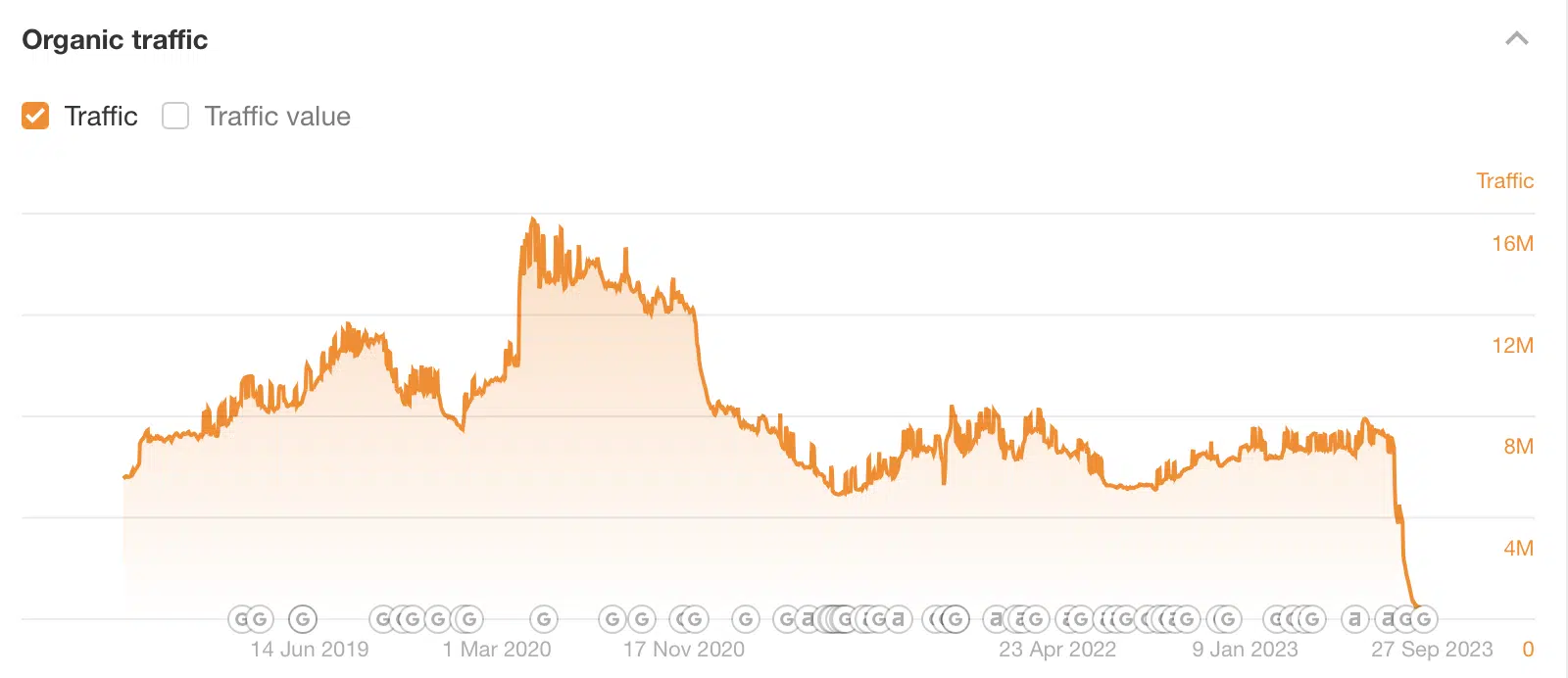Overstock’s Bed Bath & Beyond rebrand: The SEO impact
Merging two websites is difficult and complex. Find out how Bed, Bath & Beyond did – plus SEO considerations for a migration.
Overstock relaunched as Bed Bath & Beyond on Aug. 1. Many SEO professionals have been critical of the move as the community has begun analyzing early data.
The primary complaint is that overstock.com did not cleanly 301 redirect all URLs to an equal counterpart on bedbathandbeyond.com. Thousands of URLs have not been redirected, and many more were blanketly redirected to the bedbathandbeyond.com homepage.
There are multiple reasons this might have happened.
- The Overstock team determined that certain URLs didn’t contain enough value to burden with a redirect.
- There may have been business reasons for not making the connection, such as reducing the number of products sold on the site.
- The initial merger was the MVP (minimal viable product) and the migration will be released in phases.
Why the merger was big SEO news
Overstock was founded in 1999 as a digital-only shopping destination that offered consumers deals on liquidated inventory. Over the last 20 years, they have evolved into a shopping destination spanning multiple categories.
Everyone knows Bed Bath & Beyond (BB&B) as the store that mails out a blue and white postcard with a discount. The store was founded in 1971 as a fixture in strip malls and suburban areas. As the name implies, the store specializes in home goods, primarily in the bed, bath and kitchen categories.
These two stores were powerhouses online for much of the last 20 years. Their traffic levels were significant among online retailers, making the merger such a big deal for search marketers.
Overstock’s organic traffic peaked during the pandemic when everyone was forced to shop online. Still, they couldn’t sustain their growth, losing market share to Amazon and other online retailers.

Bed Bath & Beyond’s organic traffic peaked prior to the pandemic but never recovered post-pandemic.

Traffic is growing, but still below pre-bankruptcy levels
Over three weeks after the migration, the initial results have been OK. That said, organic traffic has yet to rebound to pre-Overstock levels, according to Ahrefs.

It is not expected that BB&B’s website will reach pre-bankruptcy traffic and absorb Overstock’s organic traffic.
Much of bedbathandbeyond.com’s organic traffic prior to the bankruptcy was customers looking for coveted blue coupons, shopping online for store pickup, or looking at products and then shopping in-store.
It’s safe to assume that BB&B can rise above their pre-bankruptcy organic traffic levels with the combined sites’ organic traffic but below the aggregate traffic totals of overstock.com and bedbathandbeyond.com.
Why won’t BB&B reach the aggregate traffic totals of the two sites?
Partially for the reasons above (mainly shopping online and in-store pickup and people looking to shop in-store) and also due to product and other page overlap.
Many of the categories are the same and will be consolidated on BB&B. There are likely thousands of products that are the same, in which case those pages will be consolidated.
Due to these variables, traffic will be less than the previous sum of both sites. However, over time, BB&B can earn incremental traffic across pages that cater to customers in each stage of their shopping journey.
Where does Bed Bath & Beyond go from here?
Here are some additional steps that bedbathandbeyond.com can take to boost its organic traffic.
- Focus on category page performance, which has declined since bedbathandbeyond.com declared bankruptcy.
- To counter this decline, the company should focus on improving the content related to its products on these category pages.
- By updating and enhancing the information on these pages, the company can work to regain its lost search engine rankings.

vs.

- Assuming the migration is completed in steps, URLs redirected to the homepage should be redirected to the closest counterpart on bedbathandbeyond.com.
- To capitalize on the recent improvement in search engine rankings, the company could create individual pages on the new BB&B website that correspond directly to the content from the old website. This means there should be a dedicated new page on bedbathandbeyond.com for each piece of content that was moved.
- Stop the bleeding on deeper pages that contain keywords which are no longer ranking since the migration.

- Determine if the influx of new pages has compromised the internal linking structure. Create an internal linking map to ensure that priority pages remain the priority and that link equity is being spread throughout the site.
- Review crawl logs to determine if any site sections are having issues being crawled and accessed.
Dig deeper: How to complete a website shutdown with a split migration
How we would have migrated Overstock to BB&B
Migrations are difficult and complex, especially when merging and/or moving onto a new platform. A lot must happen in the right sequence to ensure the site functions as expected during launch.
When thinking of a migration from an SEO perspective, the main objective is matching pages (old to new) so that they pass their value onto the new pages. While this sounds simple, there are a number of steps that must be planned and executed.
Here are the steps we would take at our agency to ensure that all angles are being considered and that the old site is prepared to pass value onto the new pages:
- Review content on templated pages (e.g., product, category pages) and other content contained in buyer’s guides, blogs, how-to articles, etc.
- Review traffic data to determine which content should be kept on the new version of the site and which content can be retired.
- Once URL structure is understood on the new site, create a URL map that details redirects needed (e.g., single page level or directory level redirects).
- Create rules for programmatic update of internal links.
- Create canonical tag logic for the new pages on the new site.
- Update href-lang links to pages on the new site.
- Create XML sitemap strategy and QA once implemented.
- Review the site from a technical point of view in a sandbox environment to ensure that the site has no major issues and structured data is included on key pages.
- Ensure site speed is addressed for both mobile and desktop.
- Update robots.txt file. List any new XML sitemaps and remove all old references to the old site.
- Validate all changes prior to going live in the sandbox environment.
- Conduct post-migration steps, hotfix important issues, and add less-important issues to the dev backlog.
With most migrations, there will be some hiccups even if all the steps are followed.
It could be an issue with data migration, incorrect canonical logic, or a directive in the robots.txt file that blocks the site from being crawled.
As an SEO, you need to find and fix issues quickly. Product and development teams must be aligned to handle these hotfixes quickly.
Exploring the SEO impact of Overstock and Bed Bath & Beyond’s website merger
So, has it been a perfect migration? Not quite. But it’s also not as bad as some SEOs were initially reporting.
Organic traffic is growing, the number of keywords ranking is increasing, and the BB&B team is learning more about the site daily.
There are clear growth opportunities that the SEO and content teams can undertake. Adding content over time to priority category and subcategory pages would be among the most impactful tasks the BB&B team can tackle.
Also, a focus on internal linking and ensuring the entire site is crawlable and indexable.
The core focus must be getting people comfortable shopping on the new BB&B site. In time, traffic will grow organically if the brand reestablishes itself as a leader in shopping for home goods. W
hile these two combined powerhouses have the potential to eat market share, there are still many risks in the space – giants like Amazon and smaller companies – as DTC businesses continue to grow in popularity due to their ability to adapt to market needs.
Contributing authors are invited to create content for Search Engine Land and are chosen for their expertise and contribution to the search community. Our contributors work under the oversight of the editorial staff and contributions are checked for quality and relevance to our readers. The opinions they express are their own.
Related stories
New on Search Engine Land